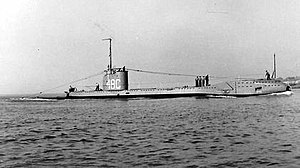HMS Undine (N48)

| |
| History | |
|---|---|
| Name | HMS Undine |
| Builder | Vickers Armstrong, Barrow-in-Furness |
| Laid down | 19 February 1937 |
| Launched | 5 October 1937 |
| Commissioned | 21 August 1938 |
| Fate | Sunk 7 January 1940 |
| Badge |  |
| General characteristics | |
| Class and type | British U-class submarine |
| Displacement | list error: <br /> list (help) Surfaced - 540 tons standard, 630 tons full load Submerged - 730 tons |
| Length | 58.22 m (191.5 ft) |
| Beam | 4.90 m (16 ft 1 in) |
| Draught | 4.62 m (15 ft 2 in) |
| Propulsion | list error: <br /> list (help) 2 shaft diesel-electric 2 Paxman Ricardo diesel generators + electric motors 615 / 825 hp |
| Speed | list error: <br /> list (help) 11.25 knots max surfaced 10 knots max submerged |
| Complement | 27 |
| Armament | list error: <br /> list (help) 4 bow internal 21 inch torpedo tubes, 2 external 10 torpedoes 3 anti-aircraft machine guns |
HMS Undine was a British U-class submarine built by Vickers Armstrong, Barrow-in-Furness. She was laid down on 19 February 1937 and was commissioned on 21 August 1938. She was the lead ship of the first group of the U class, which is sometimes called the Undine class.
Sinking
Undine was on her fourth war patrol in January 1940 when her sonar failed due to a leak. At 0940 on 7 January, she sighted what was thought to be three trawlers 20 miles west of Heligoland; but were in fact the German auxiliary minesweepers M-1201, M-1204 and M-1207. She unsuccessfully attacked the leading vessel, but the minesweepers counter attacked and forced her to dive. Undine was at 50 feet and proceeding blind due to the loss of sonar. After five minutes with no further attacks, she raised her periscope. As she did so, an explosion shook the submarine, blowing her upwards and rendering the hydroplanes useless. Without the use of the hydroplanes, escape would have been impossible and the order to abandon ship was given. Whilst the crew entered the water, to be picked up by the minesweepers, Undine was scuttled.[1][2]
See also
Notes
- ^ Submarine losses 1904 to present day, RN Submarine Museum, Gosport
- ^ HMS Undine, Uboot.net
References
- Colledge, J. J.; Warlow, Ben (2006) [1969]. Ships of the Royal Navy: The Complete Record of all Fighting Ships of the Royal Navy (Rev. ed.). London: Chatham Publishing. ISBN 978-1-86176-281-8.
- Hutchinson, Robert (2001). Jane's Submarines: War Beneath the Waves from 1776 to the Present Day. London: HarperCollins. ISBN 978-0-00-710558-8. OCLC 53783010.
